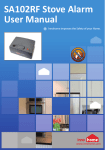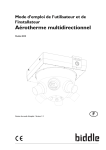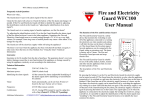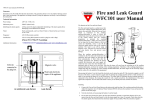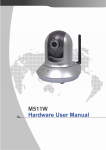Transcript
User Manual Stove Alarm SA102 1 The Stove Alarm, attached to the cooker hood by magnets, signals if the stove overheats or an empty hotplate is left on. The Alarm signals at a very early phase of a risk situation, before any damage occurs. When an empty hotplate is left on or food dries out in a pan, the Stove Alarm signals after 3-30 minutes, depending on the power of the hotplate. How does the alarm work? The Alarm functions by measuring temperature changes on the lower surface of the cooker hood. A quick change in the temperature indicates stove overheating, which sets off the alarm before any damage occurs. The temperature only changes quickly in hazardous situations: in normal cooking the temperature changes are slower as the food and the pot together heat up more slowly than an empty hotplate or a pot dry of liquid. The Stove Alarm is not triggered if the following situations: - the hotplate is left on in such a low heat that the environment isn’t heated enough for the alarm to identify a risk situation - a thermostat or the automation of the stove limits the heating. The Stove Alarm is an additional safety device that doesn’t necessarily cover all possible hazardous situations but significantly improves stove safety. 2 3 Description of the Stove Alarm The button on top of the Stove Alarm (1) resets the alarm and teaches the Stove Alarm the required level of sensitivity. The signal light (3) is lit every minute when the Stove Alarm is on, or when pushing the button. Unscrewing the screw on the top of the Alarm (2) opens it to change the battery. The Stove Alarm can be attached to a plastic or aluminium cooker hood or to a wall, using the fitting provided (4). Installation 1. Allow the Stove Alarm to adjust to room temperature by letting it sit for about fifteen minutes in the room where it is to be used before installation. 2. Remove the protective plastic slip from the bottom of the Stove Alarm. The Alarm will emit a signal as the battery is being connected. 3. Set the Stove Alarm on the bottom surface of the cooker hood, directly above the central point of the hotplates if possible, but not close to a lamp. The distance between the stove and the Stove Alarm should be approximately 50-65 cm. If the magnet doesn't hold the stove alarm in place. attach it with a screw and double-sided tape, using the fitting. If there is no cooker hood the Stove Alarm should be attached to the wall, approximately 60 cm above the stove. 4. To test the Stove Alarm, turn the smallest empty hotplate to its maximum heat, and wait until the alarm sounds. Normally this will happen after 3-10 minutes, depending on the stove. Reset the alarm by pushing the button on the Stove Alarm (1) twice. When starting to use the Stove Alarm, it may give a couple of false alarms before it has set itself to the correct sensitivity level. Push the button (1) once while the false alarm is being sounded; this causes the alarm to set its sensitivity to a more suitable level. Setting the sensitivity level The sensitivity level reflects the magnitude of heat changes which may lead to a hazardous situation and therefore will cause the Stove Alarm to react. This will vary depending on the stove. The sensitivity level is factory set to suit the majority of stoves (given a distance between the Stove Alarm and the stove of about 50-65 cm), and in most cases there is no need for readjustment. The sensitivity level can be adjusted if needed, from 1 to 15 (factory setting 5), where 1 represents the most sensitive and 15 the least sensitive level. To increase the Alarm's sensitivity by one level, it is adjusted from level five (5) to level four (4), for instance. The sensitivity is adjusted by pressing the button (1) twice, first for 5 seconds and then until the Stove Alarm gives out a short signal. Now press the button (1) as many times as is the level you wish to set it to: for level four (4), for example, press the button four times. The factory setting of the Stove Alarm is level five (5). When the Stove Alarm’s location is changed, the factory settings should be restored so that the Alarm can adjust itself to the new conditions. This is done by pressing the button (1) twice, first for about 5 seconds and then until the Alarm gives out a short signal. After hearing the signal, press the button (1) briefly 5 times. After a short while the Stove Alarm will give out five short signals, followed by another set of five short signals. This indicates that the Alarm's factory settings have been restored. The sensitivity level is also set automatically, during false alarms. If the Stove Alarm starts to signal in a normal, non-hazardous situation, reset the alarm by pressing the button (1) ONCE, until the signal stops. The Stove Alarm will then automatically adjust its sensitivity level. If the Stove Alarm does not give an alarm when testing, the sensitivity level may need to be adjusted. Resetting the alarm In a hazardous situation the alarm is reset by pressing the button (1) calmly TWICE, the second time as long as it takes for the alarm signal to stop. After resetting the alarm in this way, no further alarms will sound for the next 30 minutes. The alarm is also reset automatically when the temperature starts to fall. When initially using the Stove Alarm it may need to be taught the correct temperatures at which to react for a particular stove. If the Stove Alarm emits a false alarm, reset the alarm by pressing the button (1) ONCE, until the signal stops. The Stove Alarm will then automatically adjust its sensitivity level. A weak battery causes the Stove Alarm to emit a signal every minute. The battery alarm can be reset by pushing the button (1). The Stove Alarm will restart the battery alarm after 12 hours if the battery has not been replaced. Monthly Testing It is very important to test the Alarm at least once a month by pressing the button (1) once. Clean the Stove Alarm and change the batteries according to the instructions. The Stove Alarm is cleaned by wiping it with a damp cloth, using household detergent and water. Only use a cloth that doesn’t leave any fibres. To clean any dirt deposits from the Alarm, unscrew the screw (2) to remove the casing, remove the electronic parts, and wash the casing with household detergent and water. It is recommended to clean the alarm in this way when the battery is changed, or more frequently if required. Make sure all the parts are completely dry before reassembling the alarm. Troubleshooting What to do when...the alarm sounds in a non-hazardous situation? When initially using the Stove Alarm it may need to be taught the correct temperatures at which to react for a particular stove. If the Stove Alarm emits a false alarm, reset the alarm by pressing the button (1) ONCE, until the signal stops. The Stove Alarm will then automatically adjust its sensitivity level. - No alarm sounds when testing the Stove Alarm by turning an empty hotplate on? - Either restore the Alarm to its factory settings, or set the sensitivity level to a lower number (see 'Setting the sensitivity level'). - No test alarm sounds when pressing the button (1)? - f the Alarm neither emits a signal nor flashes its light when the button is pressed, the battery is empty. To change the battery, open the case by unscrewing the screw (2). Use only CR2032 type batteries. - No test alarm sounds even though the battery has been changed? Check that the button is free to move. If stuck, wash the alarm casing (see 'Monthly testing'). If the device still doesn’t work, contact the retailer. Guarantee The Stove Alarm comes with a 24 month guarantee from the date of purchase. The guarantee does not cover careless use of the appliance or use of the Stove Alarm other than in accordance with the instructions, or indirect damage caused due to malfunctioning of the appliance itself. Technical Information Power rating: Battery powered. Battery life approximately 10 years (without alarms). Please note that lithium batteries are hazardous waste and must be disposed of accordingly. Alarms: Overheating of the stove and an empty battery. Approximately 90 dB /10cm. Sensitivity: Adjustable sensitivity level 1-15 (factory set to 5) Certification: CE, Casing IP20 (Patent FI 117526, PCT pending EU-conformity / EU-vaatimuksenmukaisuusvaatimus / EU-Samsvarserklærig / Type / Laitetyyppi / Type: alarm / Hälytin / Alarmen / Larm Model / Tyyppimerkintä / Model / Typ: SA100 Directive/Direktiivit/Directivet/ Direktiv: 89/336/EEC, 93/68/EEC Manufacturer / Valmistaja / Producent, Adresse / Tillverkare: Innohome Oy Westendinkatu 7, 02160 Espoo Further information +358(0)941143357 [email protected] www.innohome.com Espoo Finland 13.1.2011 Matti Myllymäki

